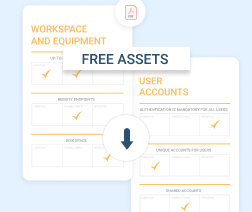If we’re being honest, one thing you’ll admit about the human brain is, it can’t always be relied on. It tends to forget even the most important steps in routine processes.
Now that’s precisely where checklists come in. Although they are often overlooked, checklists are critical in organizing all sorts of projects. But not just in the MSP world. If you keenly observe other professionals, you’ll notice that pretty much everyone is now using checklists in their work environments. This article explores the whole issue in detail to give you valuable insights about leveraging checklists in your MSP business. Plus, it outlines the relevance of checklists in different processes, and then goes ahead and explains the real difference between standard operating procedures (SOPs) and checklists.
Why MSPs Need Checklists
On the face of it, a checklist might sound so basic and simple. And yes, more often than not, checklists may seem unnecessary, especially when it comes to standard routines you’re already used to.
Whether you’re appraising your system inventory, or maybe setting up a new service for a client, the truth of the matter is, you can’t really count on your brain to keep up with all the tasks. But, with a checklist, it becomes conveniently easy not only to follow up on everything but also to standardize the whole procedure across the entire organization.
A checklist essentially provides a head start by telling you what to do, when to do it, and what to do next. You can think of it as a straightforward list that systematically outlines all the steps you should follow to perform a task.
This chronological breakdown of procedures boosts efficiency in many different ways. And to sum it all up, here are the principal benefits you should expect from checklists over the long haul.
The Benefits of Using Checklists in Your MSP Organization
Reduces mistakes: By providing a clear outline of all the tasks involved, checklists serve as templates for ensuring that procedures are carried out accordingly. This reduces the rate and number of errors in your day-to-day IT processes.
Expands knowledge: After collaborating to develop airtight checklists, MSP teams often share them with their colleagues across the entire organization. Consequently, it becomes very easy for every worker to keep up with the best procedural practices.
Standardizes business operations: For business procedures with many different approaches, a checklist fundamentally unifies all of them into one clear standard process. This streamlines business operations and enables teams to compare their performance levels more accurately.
Saves time: By establishing standard workflows for each process, checklists remind professionals what they need to do at each stage, and subsequently prevent task duplication. This means that, in the end, your members are likely to spend much less time handling various processes.
Defines roles: Thanks to their task breakdowns, checklists provide a framework for coordinating everything down to the last detail. That includes assigning jobs to the relevant professionals.
Prioritizes tasks: Checklists provide a log of tasks, as well as a corresponding sequence of execution. This helps you identify exactly what you need to handle first, before proceeding to the next step.
Having said that, let’s now explore the types of checklists you should expect in a typical MSP organization.
Checklists for Managed Service Providers
You can set up a checklist for all your projects if you want to. But here are some of the most critical procedures you might want to prioritize for all-round efficiency. You should have a checklist for:
- Client onboarding
- Client offboarding
- PC installs
- Releasing departing users
- Daily, weekly, and monthly routine tasks
- Client discovery via calls and onsite
- Setting up and migrating servers and apps
- Inventory management
- Creating secure configurations for hardware, software, and network devices
- Vulnerability assessment and remediation
- Applying, revoking, and controlling administrative account privileges
- Maintenance, monitoring, and analysis of audit logs
- Implementing and reviewing system security, including protocols, boundary defense, plus email and web browser protection
- Managing network ports and services.
SOPs vs. Checklists
As you consider all these parameters, here’s a word of caution: don’t confuse checklists with SOPs. Although they share a couple of things in common here and there, SOPs and checklists are not really the same.
Standard operating procedures, or SOPs for short, describe processes in terms of structures, goals, and the variables involved. So, in other words, they go into all the details, explaining how, when, and what to do. What’s more, they even come with detailed tables and image illustrations.
Checklists, on the other hand, are basic lists that identify what to do, as well as the sequence of execution. They help you perform the tasks, while SOPs are best reserved for training.
Best Practices for MSP Checklists
After coming up with relevant checklists for your organization, you might want to document everything accordingly. But don’t leave it at that. It’s always advisable to review the procedures from time to time while keeping the documents up-to-date.
Also, you should consider creating a distinct checklist copy for every single server, endpoint, and client. Then, for easy access and management, keep each record separately in its client folder.
The Final Word
All things considered, checklists are undeniably essential to all types of MSP businesses. And the best thing is, it doesn’t take much to apply them across the board, especially if you use the insights provided by Atul Gawande in his book The Checklist Manifesto.
You might want to get yourself a copy.





